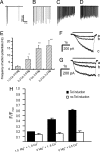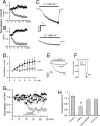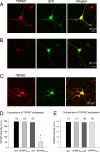TRPM7 channels in hippocampal neurons detect levels of extracellular divalent cations
- PMID: 17913893
- PMCID: PMC2042205
- DOI: 10.1073/pnas.0701149104
TRPM7 channels in hippocampal neurons detect levels of extracellular divalent cations
Abstract
Exposure to low Ca(2+) and/or Mg(2+) is tolerated by cardiac myocytes, astrocytes, and neurons, but restoration to normal divalent cation levels paradoxically causes Ca(2+) overload and cell death. This phenomenon has been called the "Ca(2+) paradox" of ischemia-reperfusion. The mechanism by which a decrease in extracellular Ca(2+) and Mg(2+) is "detected" and triggers subsequent cell death is unknown. Transient periods of brain ischemia are characterized by substantial decreases in extracellular Ca(2+) and Mg(2+) that mimic the initial condition of the Ca(2+) paradox. In CA1 hippocampal neurons, lowering extracellular divalents stimulates a nonselective cation current. We show that this current resembles TRPM7 currents in several ways. Both (i) respond to transient decreases in extracellular divalents with inward currents and cell excitation, (ii) demonstrate outward rectification that depends on the presence of extracellular divalents, (iii) are inhibited by physiological concentrations of intracellular Mg(2+), (iv) are enhanced by intracellular phosphatidylinositol 4,5-bisphosphate (PIP(2)), and (v) can be inhibited by Galphaq-linked G protein-coupled receptors linked to phospholipase C beta1-induced hydrolysis of PIP(2). Furthermore, suppression of TRPM7 expression in hippocampal neurons strongly depressed the inward currents evoked by lowering extracellular divalents. Finally, we show that activation of TRPM7 channels by lowering divalents significantly contributes to cell death. Together, the results demonstrate that TRPM7 contributes to the mechanism by which hippocampal neurons "detect" reductions in extracellular divalents and provide a means by which TRPM7 contributes to neuronal death during transient brain ischemia.
Conflict of interest statement
The authors declare no conflict of interest.
Figures





Similar articles
-
Modulation of Human Cardiac TRPM7 Current by Extracellular Acidic pH Depends upon Extracellular Concentrations of Divalent Cations.PLoS One. 2017 Jan 27;12(1):e0170923. doi: 10.1371/journal.pone.0170923. eCollection 2017. PLoS One. 2017. PMID: 28129376 Free PMC article.
-
The modulation of TRPM7 currents by nafamostat mesilate depends directly upon extracellular concentrations of divalent cations.Mol Brain. 2010 Dec 1;3:38. doi: 10.1186/1756-6606-3-38. Mol Brain. 2010. PMID: 21122141 Free PMC article.
-
TrkA pathway(s) is involved in regulation of TRPM7 expression in hippocampal neurons subjected to ischemic-reperfusion and oxygen-glucose deprivation.Brain Res Bull. 2008 May 15;76(1-2):124-30. doi: 10.1016/j.brainresbull.2008.01.013. Epub 2008 Feb 12. Brain Res Bull. 2008. PMID: 18395621
-
Role of TRPM7 in cerebral ischaemia and hypoxia.J Physiol. 2017 May 15;595(10):3077-3083. doi: 10.1113/JP273709. Epub 2017 Feb 8. J Physiol. 2017. PMID: 27891609 Free PMC article. Review.
-
TRPM7, the Mg(2+) inhibited channel and kinase.Adv Exp Med Biol. 2011;704:173-83. doi: 10.1007/978-94-007-0265-3_9. Adv Exp Med Biol. 2011. PMID: 21290295 Review.
Cited by
-
The Outwardly Rectifying Current of Layer 5 Neocortical Neurons that was Originally Identified as "Non-Specific Cationic" Is Essentially a Potassium Current.PLoS One. 2015 Jul 21;10(7):e0132108. doi: 10.1371/journal.pone.0132108. eCollection 2015. PLoS One. 2015. PMID: 26197082 Free PMC article.
-
Ischemia-Reperfusion Increases TRPM7 Expression in Mouse Retinas.Int J Mol Sci. 2023 Nov 8;24(22):16068. doi: 10.3390/ijms242216068. Int J Mol Sci. 2023. PMID: 38003256 Free PMC article.
-
TRPM7 is a unique target for therapeutic intervention of stroke.Int J Physiol Pathophysiol Pharmacol. 2017 Dec 25;9(6):211-216. eCollection 2017. Int J Physiol Pathophysiol Pharmacol. 2017. PMID: 29348798 Free PMC article. Review.
-
Local anesthetic lidocaine inhibits TRPM7 current and TRPM7-mediated zinc toxicity.CNS Neurosci Ther. 2015 Jan;21(1):32-9. doi: 10.1111/cns.12318. Epub 2014 Aug 28. CNS Neurosci Ther. 2015. PMID: 25169754 Free PMC article.
-
Blockade of TRPM7 channel activity and cell death by inhibitors of 5-lipoxygenase.PLoS One. 2010 Jun 17;5(6):e11161. doi: 10.1371/journal.pone.0011161. PLoS One. 2010. PMID: 20567598 Free PMC article.
References
-
- Piper HM. Cardiovasc Res. 2000;45:123–127. - PubMed
-
- Young W. Cent Nerv Syst Trauma. 1986;3:235–251. - PubMed
-
- Morris ME, Trippenbach T. Am J Physiol. 1993;264:R761–R769. - PubMed
-
- Kristian T, Siesjo BK. Stroke. 1998;29:705–718. - PubMed
-
- Heinemann U, Stabel J, Rausche G. Prog Brain Res. 1990;83:197–214. - PubMed
Publication types
MeSH terms
Substances
LinkOut - more resources
Full Text Sources
Miscellaneous

